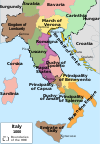
The Lombards or Longobards were a Germanic people who conquered most of the Italian Peninsula between 568 and 774.
The 660s decade ran from January 1, 660, to December 31, 669.
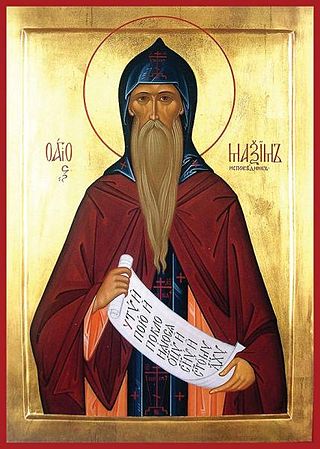
Year 662 (DCLXII) was a common year starting on Saturday of the Julian calendar. The denomination 662 for this year has been used since the early medieval period, when the Anno Domini calendar era became the prevalent method in Europe for naming years.
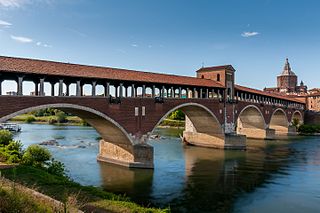
Pavia is a town and comune of south-western Lombardy, in Northern Italy, 35 kilometres south of Milan on the lower Ticino near its confluence with the Po. It has a population of c. 73,086.

The siege or battle of Pavia was fought in 773–774 in northern Italy, near Ticinum, and resulted in the victory of the Franks under Charlemagne against the Lombards under King Desiderius.

The Duchy of Benevento was the southernmost Lombard duchy in the Italian Peninsula that was centered in Benevento, a city in Southern Italy. Lombard dukes ruled Benevento from 571 to 774, when the Kingdom of the Lombards was conquered by the Kingdom of the Franks. Being cut off from the rest of the Lombard possessions by the papal Duchy of Rome, Benevento always had held some degree of independence. Only during the reigns of Grimoald and the kings from Liutprand on was the duchy closely tied to the Kingdom of the Lombards. After the fall of the in 774, the duchy became the sole Lombard territory which continued to exist as a rump state, maintaining its de facto independence for nearly 300 years as the Principality of Benevento.

The Agilolfings were a noble family that ruled the Duchy of Bavaria on behalf of their Merovingian suzerains from about 550 until 788. A cadet branch of the Agilolfings also ruled the Kingdom of the Lombards intermittently from 616 to 712. They are mentioned as the leading dynasty in the Lex Baiuvariorum. Their Bavarian residence was at Regensburg.

Rothari, of the house of Arodus, was king of the Lombards from 636 to 652; previously he had been duke of Brescia. He succeeded Arioald, who was an Arian like himself, and was one of the most energetic of Lombard kings. Fredegar relates that at the beginning of his reign he put to death many insubordinate nobles, and that in his efforts for peace he maintained very strict discipline.
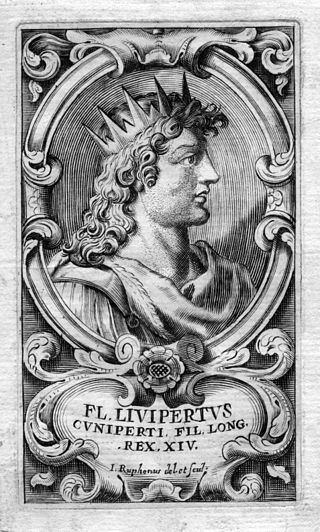
Liutpert was the Lombard king of Italy between 700 and 702, with interruption. Upon succeeding his father, King Cunincpert, at a young age, he ruled together with his tutor, Ansprand, the duke of Asti. After eight months, he was deposed by Raginpert, the duke of Turin and son of Godepert, Liutpert's great-uncle, but succeeded in returning to the throne several months later upon Raginpert's death, only to be deposed again, taken captive from Pavia, and drowned by Aripert II, Raginpert's son. He was buried in the Basilica of Santissimo Salvatore in Pavia.

Aripert I was king of the Lombards (653–661) in Italy. He was the son of Gundoald, Duke of Asti, who had crossed the Alps from Bavaria with his sister Theodelinda. As a relative of the Bavarian ducal house, his was called the Bavarian Dynasty.

Perctarit was the first Catholic king of the Lombards who lead a religiously divided kingdom during the 7th Century. He ruled from 661 to 662 the first time and later from 671 to 688. He is significant for making Catholicism the official religion, sparing the life of an invading leader, and building projects around the capital.

Grimoald or Grimwald (†671) was a 7th-century King of Italy, ruling as Duke of Benevento from 647 to 662, and then as King of the Lombards from 662 until his death in 671.

Adalgis or Adelchis was an associate king of the Lombards from August 759, reigning with his father, Desiderius, until their deposition in June 774. He is also remembered today as the hero of the play Adelchi (1822) by Alessandro Manzoni.

Arechis II was a Duke of Benevento, in Southern Italy. He sought to expand the Beneventos' influence into areas of Italy that were still under Byzantine control, but he also had to defend against Charlemagne, who had conquered northern Italy.
The Bavarian dynasty was those kings of the Lombards who were descended from Garibald I, the Agilolfing duke of Bavaria. They came to rule the Lombards through Garibald's daughter Theodelinda, who married the Lombard king Authari in 588. The Bavarians were really a branch of the Agilolfings, and were themselves two branches: the branch descended in the female line through Garibald's eldest child and daughter, Theodelinda, and the branch descended from Garibald's eldest son Gundoald. Of the first branch, only Adaloald, Theodelinda's son by her second husband, whom she had chosen to be king, Agilulf, reigned, though her son-in-law Arioald also ruled. Through Gundoald, six kings reigned in succession, broken only by the usurper Grimuald, who married Gundoald's granddaughter:

Theodo, also known as Theodo V and Theodo II, was the Duke of Bavaria from 670 or, more probably, 680 to his death. It is with Theodo that the well-sourced history of Bavaria begins. He strengthened his duchy internally and externally and, according to the medieval chronicler Arbeo of Freising, he was a prince of great power whose fame extended beyond his borders.
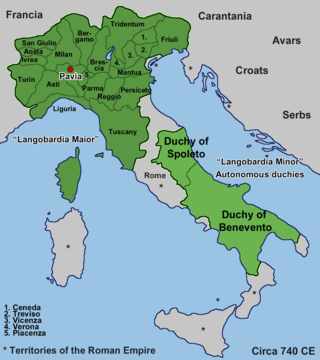
The Kingdom of the Lombards, also known as the Lombard Kingdom and later as the Kingdom of all Italy, was an early medieval state established by the Lombards, a Germanic people, on the Italian Peninsula in the latter part of the 6th century. The king was traditionally elected by the very highest-ranking aristocrats, the dukes, as several attempts to establish a hereditary dynasty failed. The kingdom was subdivided into a varying number of duchies, ruled by semi-autonomous dukes, which were in turn subdivided into gastaldates at the municipal level. The capital of the kingdom and the center of its political life was Pavia in the modern northern Italian region of Lombardy.

The Duchy of Friuli was a Lombard duchy in present-day Friuli, the first to be established after the conquest of the Italian peninsula in 568. It was one of the largest domains in Langobardia Major and an important buffer between the Lombard kingdom and the Slavs, Avars, and the Byzantine Empire. The original chief city in the province was Roman Aquileia, but the Lombard capital of Friuli was Forum Julii, modern Cividale.
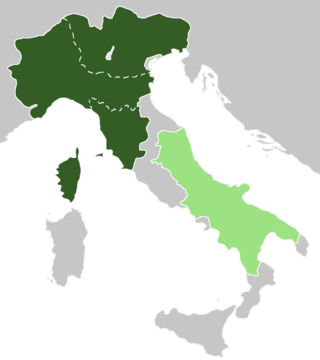
Austria was, according to the early medieval geographical classification, the eastern portion of Langobardia Major, the north-central part of the Lombard Kingdom, extended from the Adda to Friuli and opposite to Neustria. The partition had not only been territorial, but also implied significant cultural and political differences.

The Basilica of Santissimo Salvatore is a Roman Catholic church in Pavia, region of Lombardy, Italy. It was founded in 657 by the Lombard king Aripert I and became a mausoleum for many of the Lombard kings.

















